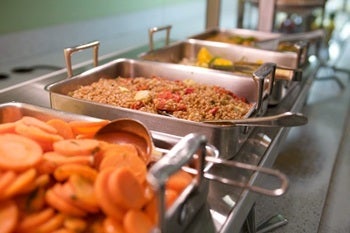July 9, 2010 — The employees at Sebastian’s Café face a tall order. Housed in the same school as a renowned Department of Nutrition, they need to deliver high-quality, healthy food options each day, while satisfying different budgets and tastebuds. How do they manage? Manager Laurie Torf and Catering Manager Tom Quinn provide some insights into how the busy café works.
Q: How have you kept aligned with the work of Professor Walter Willett and the Department of Nutrition?
A: The Healthy Eating Pyramid is the basis for all our menus—within any Harvard University Dining Services operation, including the undergraduate board program. We emphasize fruits and vegetables, healthy fats, whole grains, and lean proteins. Even with something like pizza, we have options that feature whole-grain crust, low-fat cheese, and lots of vegetables. We meet with the Department of Nutrition to learn new findings and to bring them to life in the real-world setting that is Sebastian’s Café.
Q: How do you balance “nutrition” and “taste”?
A: “Healthy” does not preclude “taste.” Our menu has something for everyone and every taste, from indulgent to austere. Even the healthiest choices will be full of flavor—be it from seasonings, or healthy oils, or the freshest ingredients. One of the greatest misconceptions that we hope to combat with our menu every day is that if you are eating “healthy” you are sacrificing flavor.
Q: Where do you get your recipes?
A: Some of the recipes for the “Heart of the Plate” station were developed with Mollie Katzen, a cookbook author. The “Heart of the Plate” selection always has two healthy entrees, such as grilled tofu and salmon, along with hearty vegetables and beans. In addition, Sebastian’s chefs Martin Breslin and Patricia Gregory collaborate and develop the overall menus for the café and catering.
Q: What’s the most popular cafeteria or catering dish?
A: The salad bar and the “Heart of the Plate” items are the most popular. Comfort foods, such as meatloaf, chicken fingers, and macaroni and cheese, are always well received.
Q: Do you use locally grown foods?
A: Roughly 25 percent of our food is from local sources.
Q: What is your busiest time of the year?
A: The start of any semester and Commencement week
Q: How busy is a normal day?
A: We have anywhere from 1,200 to 1,350 transactions a day in the café. Catering events of various sizes can total more than 30 events on some days.
Q: How do you help people with food allergies?
A: Customers will generally let us know if they have food allergies, and we proceed from there in building a relationship with them to understand their unique needs. We make sure the staff are alerted to potential allergens in any recipe or food, so that we can be on the lookout.
Q: Are there common possibly allergenic foods you totally avoid?
A: Pine nuts
Q: Do you have special lower-salt and lower-sugar dishes?
A: We are currently working to reduce the amount of salt in our recipes, and we provide an array of unsweetened beverages and good choices that meet the criteria on the HSPH chart How Sweet It Is.
Q: What do you do for vegetarians or vegans?
A: We have many options, starting with a salad bar that has more than 50 items. The “Heart of the Plate” station always has grilled tofu as an option. The Indian station has vegetarian or vegan options, and at least one soup every day is vegetarian or vegan.
Q: How do you prepare food for a School with so many different palates?
A. Part of what makes dining fun today is that cuisine is so global—at every meal, our staff and our customers have the opportunity to explore the world through what is prepared and offered. Food is universal, and we take pride every day in presenting a fresh, innovative, diverse menu, and listening to what our customers enjoy or crave.
–Larry Hand.
Photo by Kent Dayton
